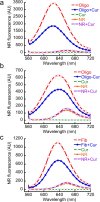Curcumin modulates α-synuclein aggregation and toxicity
- PMID: 23509976
- PMCID: PMC3605819
- DOI: 10.1021/cn3001203
Curcumin modulates α-synuclein aggregation and toxicity
Abstract
In human beings, Parkinson's disease (PD) is associated with the oligomerization and amyloid formation of α-synuclein (α-Syn). The polyphenolic Asian food ingredient curcumin has proven to be effective against a wide range of human diseases including cancers and neurological disorders. While curcumin has been shown to significantly reduce cell toxicity of α-Syn aggregates, its mechanism of action remains unexplored. Here, using a series of biophysical techniques, we demonstrate that curcumin reduces toxicity by binding to preformed oligomers and fibrils and altering their hydrophobic surface exposure. Further, our fluorescence and two-dimensional nuclear magnetic resonance (2D-NMR) data indicate that curcumin does not bind to monomeric α-Syn but binds specifically to oligomeric intermediates. The degree of curcumin binding correlates with the extent of α-Syn oligomerization, suggesting that the ordered structure of protein is required for effective curcumin binding. The acceleration of aggregation by curcumin may decrease the population of toxic oligomeric intermediates of α-Syn. Collectively; our results suggest that curcumin and related polyphenolic compounds can be pursued as candidate drug targets for treatment of PD and other neurological diseases.
Figures








Similar articles
-
Effect of curcumin analogs onα-synuclein aggregation and cytotoxicity.Sci Rep. 2016 Jun 24;6:28511. doi: 10.1038/srep28511. Sci Rep. 2016. PMID: 27338805 Free PMC article.
-
Scutellarin inhibits the uninduced and metal-induced aggregation of α-Synuclein and disaggregates preformed fibrils: implications for Parkinson's disease.Biochem J. 2020 Feb 14;477(3):645-670. doi: 10.1042/BCJ20190705. Biochem J. 2020. PMID: 31939603
-
Comparison of α-Synuclein Fibril Inhibition by Four Different Amyloid Inhibitors.ACS Chem Neurosci. 2017 Dec 20;8(12):2722-2733. doi: 10.1021/acschemneuro.7b00261. Epub 2017 Sep 21. ACS Chem Neurosci. 2017. PMID: 28872299
-
Alteration of Structure and Aggregation of α-Synuclein by Familial Parkinson's Disease Associated Mutations.Curr Protein Pept Sci. 2017;18(7):656-676. doi: 10.2174/1389203717666160314151706. Curr Protein Pept Sci. 2017. PMID: 26972727 Review.
-
Phase separation and other forms of α-Synuclein self-assemblies.Essays Biochem. 2022 Dec 16;66(7):987-1000. doi: 10.1042/EBC20220055. Essays Biochem. 2022. PMID: 36373662 Review.
Cited by
-
Effect of curcumin on amyloid-like aggregates generated from methionine-oxidized apolipoprotein A-I.FEBS Open Bio. 2018 Jan 10;8(2):302-310. doi: 10.1002/2211-5463.12372. eCollection 2018 Feb. FEBS Open Bio. 2018. PMID: 29435420 Free PMC article.
-
Synergy of the Inhibitory Action of Polyphenols Plus Vitamin C on Amyloid Fibril Formation: Case Study of Human Stefin B.Antioxidants (Basel). 2021 Sep 15;10(9):1471. doi: 10.3390/antiox10091471. Antioxidants (Basel). 2021. PMID: 34573102 Free PMC article.
-
Natural product-based amyloid inhibitors.Biochem Pharmacol. 2017 Sep 1;139:40-55. doi: 10.1016/j.bcp.2017.04.004. Epub 2017 Apr 6. Biochem Pharmacol. 2017. PMID: 28390938 Free PMC article. Review.
-
Targeted exosome coating gene-chem nanocomplex as "nanoscavenger" for clearing α-synuclein and immune activation of Parkinson's disease.Sci Adv. 2020 Dec 11;6(50):eaba3967. doi: 10.1126/sciadv.aba3967. Print 2020 Dec. Sci Adv. 2020. PMID: 33310840 Free PMC article.
-
Structure based aggregation studies reveal the presence of helix-rich intermediate during α-Synuclein aggregation.Sci Rep. 2015 Mar 18;5:9228. doi: 10.1038/srep09228. Sci Rep. 2015. PMID: 25784353 Free PMC article.
References
-
- Cookson M. R. (2005) The biochemistry of Parkinson’s disease. Annu. Rev. Biochem. 74, 29–52. - PubMed
-
- Lansbury P. T.; Brice A. (2002) Genetics of Parkinson’s disease and biochemical studies of implicated gene products - Commentary. Curr. Opin Cell. Biol. 14, 653–660. - PubMed
-
- Feany M. B. (2000) Studying human neurodegenerative diseases in flies and worms. J. Neuropathol. Exp. Neurol. 59, 847–856. - PubMed
-
- Conway K. A.; Harper J. D.; Lansbury P. T. (1998) Accelerated in vitro fibril formation by a mutant α-synuclein linked to early-onset Parkinson disease. Nat. Med. 4, 1318–1320. - PubMed
-
- Conway K. A.; Lee S. J.; Rochet J. C.; Ding T. T.; Williamson R. E.; Lansbury P. T. (2000) Acceleration of oligomerization, not fibrillization, is a shared property of both a-synuclein mutations linked to early-onset Parkinson’s disease: Implications for pathogenesis and therapy. Proc. Natl. Acad. Sci. U.S.A. 97, 571–576. - PMC - PubMed
Publication types
MeSH terms
Substances
LinkOut - more resources
Full Text Sources
Other Literature Sources
Miscellaneous

